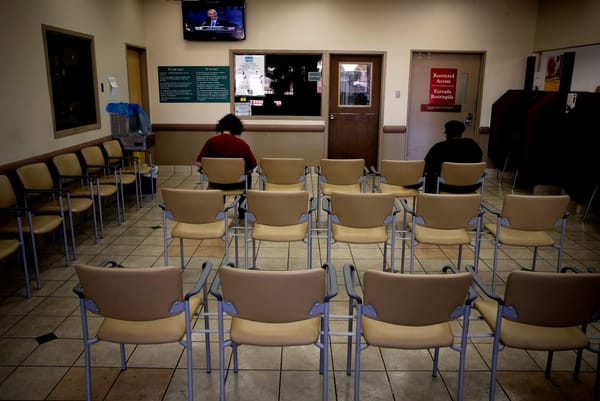It isn’t uncommon in my line of work as an emergency physician to attend to the so-called frequent flier. Frequent fliers, also known as “high utilizers” to the hospital administration, are patients who are well-known to everyone in the emergency department. Some will show up as often as several times a week with predictable complaints—chest pain, lower-back pain, anxiety, alcohol intoxication, depression, suicidal ideation. Some have a substance-abuse problem; some are homeless; many suffer from schizophrenia or other forms of psychotic or disorganized thinking. But there is only one thing I can think of that binds them all together. They are all lonely.
This makes intuitive sense. In the ER, they have a warm and safe place to be. There is often a meal available. Here, a story can be told, if not to the doctor, then to the nurse as an IV is placed or to a patient transporter as he rolls the frequent flier to radiology. Often it is us, the emergency department staff, who are these patients’ only friends, so lost are they out in the world. Nobody outside the waiting-room doors knows who the homeless Mr. J is, but every single one of us in the ER does. We have encountered him for the 137th time just this year. We know all his antics, his medication preferences, his idiosyncratic requests, his television habits. His soul is unique, but, alas, his social isolation is quotidian.
It isn’t just the frequent fliers who suffer from this plague. We are beset by an epidemic of loneliness despite being, by our very nature, social beings. People want to feel rooted within their community and connected to those around them, and yet in our hyperlinked modern world, we find fragmentation and despondency everywhere we cast our eyes. From where does this cultural disconnect arise? Technology, undoubtedly, but not only.
Machine addiction may be easily witnessed in any emergency department as parents stare at their phones while their toddlers, hardly able to speak, swipe away expertly at their tablets. Teenagers, meanwhile, are brought in for “behavioral” complaints after destroying the house when their phone was confiscated. The patient’s phone is on while we take their histories, perform physical exams, place sutures and deliver test results. Nonsensical texting has even been described as a symptom of stroke (“dystextia”). Yet, if the ubiquitous phone is both a symptom and a cause of our angst, there are other even more concerning signs seen in the ER daily.
Deaths of despair (alcoholism, drug abuse, suicide) have been rising for years, and long predated the devastations wrought by Covid-19 and our response to it. It is rare to make it through any of my overnight shifts without seeing a fentanyl overdose, fatal or not. Several years ago, I had the terrible task of informing parents that their son had died from an overdose, only to have them inform me that his sister had died the same way the year before.
“Emergency departments are the last refuge for victims of loneliness and ennui.”
In pediatrics, the ER is full of children awaiting inpatient hospitalization for acute psychiatric emergencies to a degree I would never have imagined 10 years ago. Indeed, whether it is the “worried well” or the truly despondent, our emergency departments are now the last refuge for victims of some of modernity’s greatest scourges—loneliness and ennui arising from inadequate virtual relationships and actual fentanyl.
A few months back, I saw Mr. L in the emergency department. He was a well-known frequent flier, usually appearing with chronic chest pain. He suffered from severe coronary artery disease that wasn’t amenable to any further significant interventions and, as a result, suffered from crippling anxiety. My last interaction with him happened to be on a slowish night. It was quite late, perhaps 3 or 4 a.m., when he came in, and so I had more time than I normally do. He looked as he always did on arrival—terribly anxious and clutching his chest. On that night, however, I closed the curtain and took my time. I sat down next to him and placed my hand on his, and I asked him what he did for work before he became so sick. It turns out he was a traveling salesman. He sold furniture throughout the South. He was a very good judge of craftsmanship and used to work a lathe himself. His wife had died, and his children were not speaking to him. For all intents and purposes, he was alone in the world—adrift at the end of his life with nowhere to go but the emergency department. Here, at least, people spoke with him, comforted him, and tried to help. Here he had dignity.
As we talked, he visibly relaxed and smiled. He had expressive blue eyes and a winsome smile that I had somehow failed to note on previous visits. Perhaps, I realized, I had never seen him smile before. We had a good talk but also a difficult one. We discussed his trying to follow up with his cardiologist and also with psychiatry. I brought up the possibility of a hospice consultation. He quietly shook his head. This wasn’t a conversation he was ready for. Eventually, I offered him medication for his anxiety. He declined. He said he felt better and was ready to be discharged. He died shortly afterward, so I never saw him again, but I am glad that I had the opportunity to sit down and talk with him before he passed.
Even frequent fliers eventually fly away, never to be seen again.
